Designated as the cleanest city in India, Gangtok is all about equal parts serene and equal parts hustle with the mighty Khangchendzonga as its backdrop. Gangtok offers varied experience for travelers from adventure of trekking, to mountain biking, to serenity of its monasteries. From blooming wildflowers that color the mountain slopes bright to beautiful valleys of North Sikkim to its numerous alpine, Gangtok offers something for everyone. Along with that, the glacial lakes, the wilderness of the Lepcha and the mythical land of the Jhakris add to its stunning beauty.
With diverse ecology and swathes of forests, Gangtok still features among the green capitals of the country. The city is famous not only for its natural beauty but also for the local food, for being the style capital of North East India, for its orchids and its monasteries. When you explore Sikkim, you would come to realize that there is a lot more to Sikkimese food than momos and thukpas.
If you are a person who loves shopping, Gangtok has no dearth of shopping options ranging from souvenirs, local art, local beer to apparel. Indulge in shopping while also sharpening your skills of hard bargaining.
It requires an ample amount of time to explore Gangtok to its core however, there are major places that can be explored on a 2 days’ trip too if you are running on a tight schedule.
Tashi Viewpoint, Nathu La, Khangchendzonga, Ganesh Tok, MG Marg, Tsomgo Lake, Namchi, Magnan, Tsuk La Khang Monastery, Seven sisters waterfall are few popular and major places including others to visit in 2 days in Gangtok.
Listing down your two day itinerary for Gangtok that covers almost all major landmarks and tourist hubs.
Gangtok Places to Visit in 2 days
Day 1 Gangtok Places to Visit
- Tashi View Point
- Nathu La
- MG Marg
- Khangchendzonga
- Hanuman Tok
- Ganesh Tok
- Rumtek Monastery
- Banjhakri Falls
Day 2 Gangtok Places to Visit
- Tsomgo Lake
- Namgyal Institute of Tibetology
- Namchi
- Magnan
- Tsuk La Khang Monastery
- Do Drul Chorten Stupa
- Seven Sisters Waterfalls
1. Tashi View Point
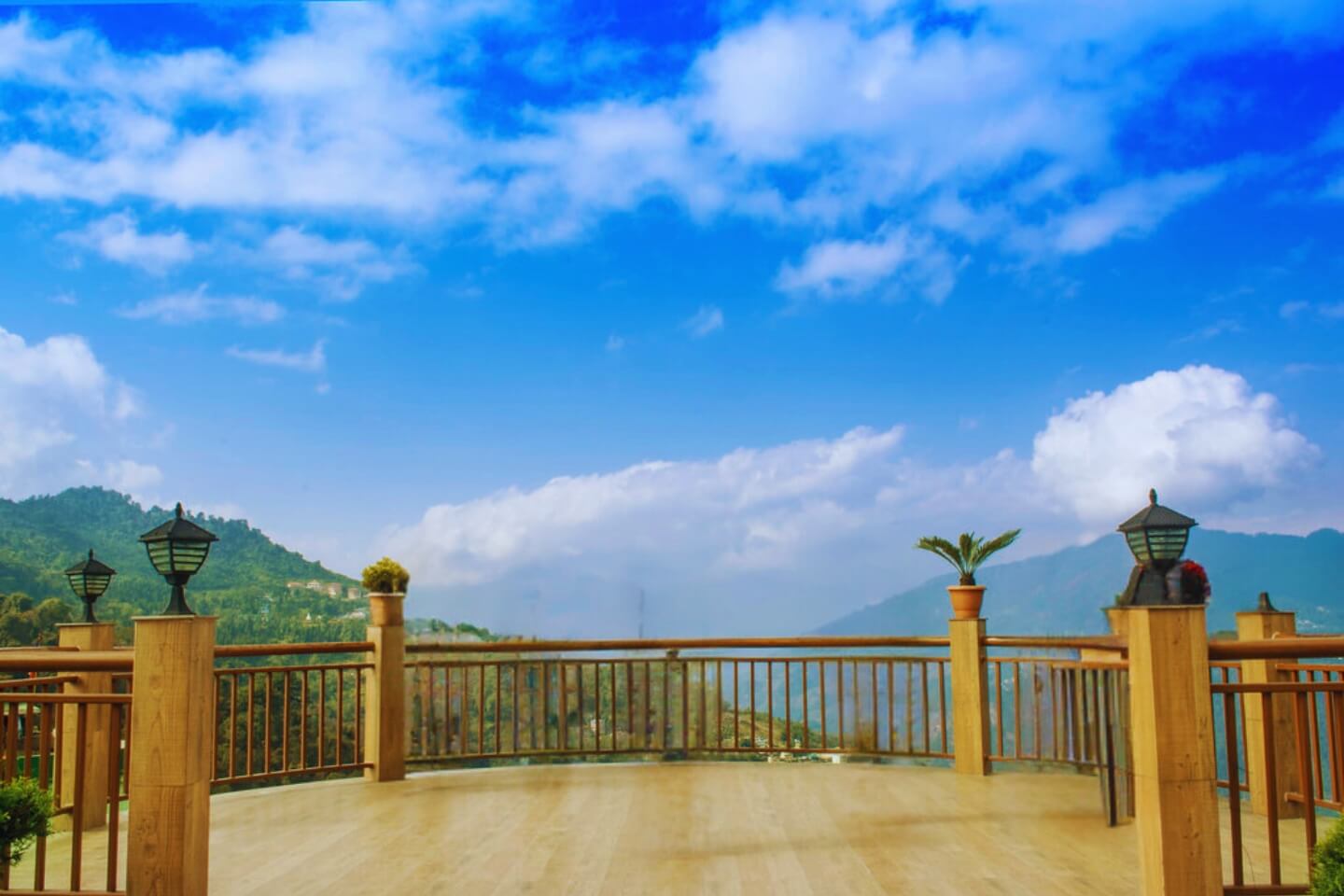
Built by Tashi Namgyal, the King of Sikkim between 1914 and 1963, the viewpoint was named after the king. Tashi View Point is located 8 kilometers from Gangtok central and is known for the view it offers of two most magnificent Himalayan peaks, Mount Khangchendzonga and Mount Sinilochu along with other snow – capped mountain peaks. The view point is developed and maintained by the Tourism Department of Sikkim. The place around the view- point is also used as a day picnic spot or weekend getaway by the locals.
It is most recommended that you visit Tashi View Point during sunrise and sunsets as you would get to see the changing colors of the mountain peaks during the golden hours. The Labrang and Phodong Monasteries are also visible from the view point. The circular balcony of the viewpoint can hold up to 20 people at one time wherein the visitors can enjoy the unpolluted air in natural ambience.
The weather between March to June is warm and pleasant and offers the best views of both Khangchendzonga and Sinilochu peaks. If you wish to witness Khangchendzonga at sunrise, make sure you reach there before dawn break.
- Timings: 5:00 AM – 6:00 PM
- Entry Fee: Free
2. Nathu La

Nathu La is one of the highest motorable mountain passes in the Eastern Himalayan range that joins India and Autonomous Region of China, and one of the hottest tourist places thronged by a large number of visitors throughout the year. The Indo-Tibetan border pass is located at 14,450 feet above the sea level and is considered to be one of the most important Himalayan passes as it is one of the three border posts that are open for trading between India and China.
The road from Gangtok to NathuLa is one of the most scenic routes with several waterfalls and snow- clad mountains that makes the visit to NathuLa a must.
Until 1962, Nathu La was an open road as a part of the famous Silk Route. Currently, due to its status as a protected and militarized zone, only Indian nationals are allowed to visit and that too after obtaining a valid permit from the Tourism and Civil Aviation Department. The permit is easy to obtain with valid ID proofs.
The best time to visit NathuLa is between December and February when the weather remains pleasant with clear skies. The pass remains closed on Mondays and Tuesdays, and is accessible only via heavy – duty vehicles.
- Timings: 8:00 AM – 6:00 PM (Closed on Mondays & Tuesdays)
- Entry Fee: Free (but permit required)
3. MG Marg
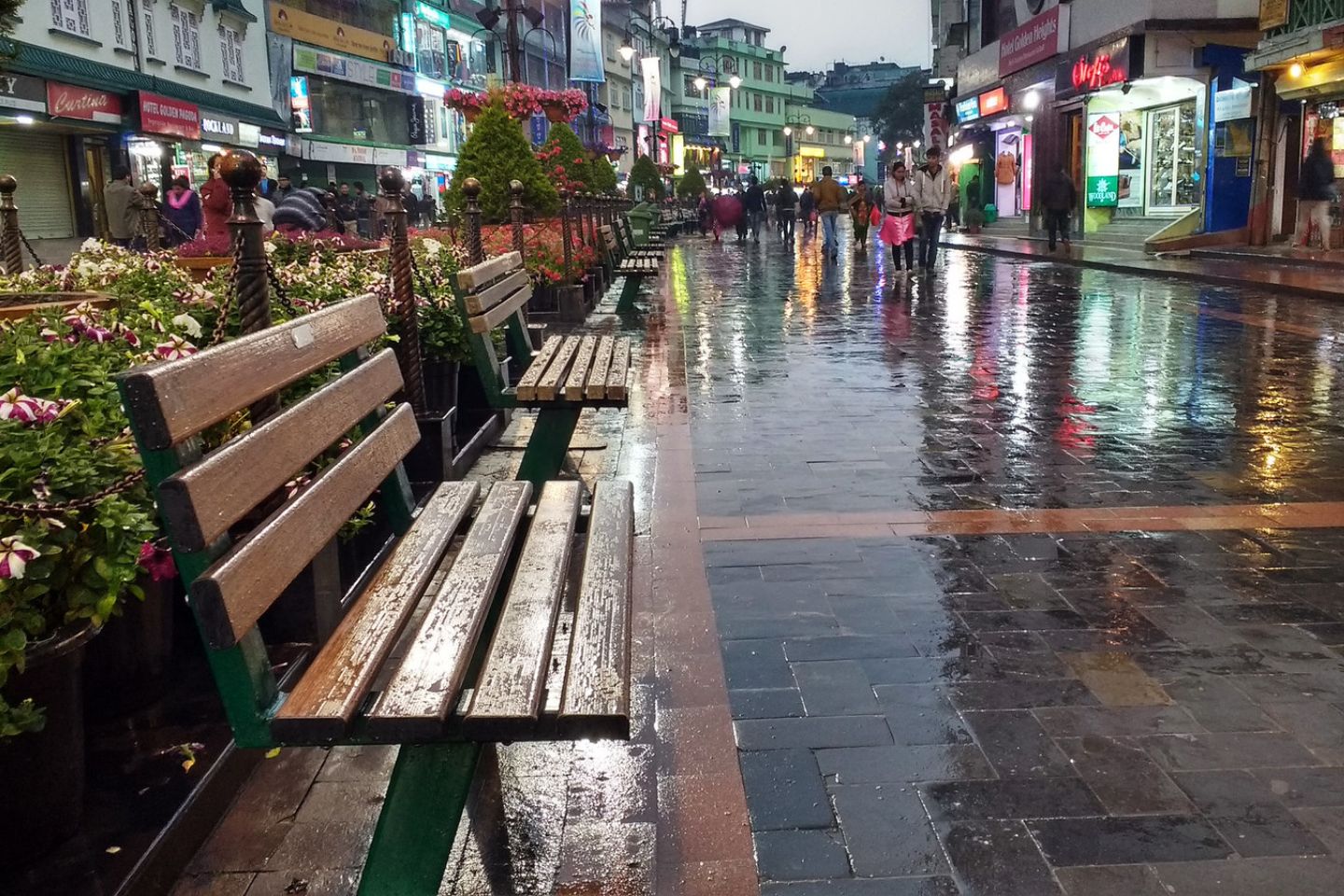
The 2 days visit to Gangtok is incomplete without a visit to the famous MG Marg. Named after Mahatma Gandhi, the MG Marg is a pedestrian only 1 kilometer stretch from the Sikkim Tourism Center to the main taxi stand at the other end. The road is filled with restaurants, pubs, discotheques, cafes and a shopping mall.
The MG Marg of Gangtok is a litter- free and smoke free zone, decorated with Victorian lamps and benches allowing visitors to have a leisure stroll across the road and enjoy the eclectic ambience. All buildings lining the MG Marg are painted in green in line with the government's green initiative.
There is a Statue of Unity which overlooks the MG Marg. This landmark promotes peace, love and harmony, and comprises statues of Bhutia Chieftain Khye Bumsa, the Lepcha leader Thetong Tek and his wife Ngo Khong ngol.
- Timings: 8:00 AM – 7:00 PM (Closed On Tuesdays)
- Entry Fee: Free
4. Khangchendzonga

A visit to Khangchendzonga is a must on your 2 day trip to Gangtok else, your visit would be considered incomplete. The majestic Khangchendzonga is the world’s third highest mountain in the world, standing tall at 8,586 meters and that ranks it among the top places and must visit places in Gangtok. The snow- clad peak of Khangchendzonga is visible from most places in Gangtok and Darjeeling and high view- points of Shillong.
The mighty mountain is surrounded by Nepal, Sikkim, Bhutan and Tibet. The name Khangchendzonga is a Tibetan name that literally translates to ‘The Five Treasures of High Snow’ and the treasures spoken here are the five peaks of Khangchendzonga, a metaphorical representation of five repositories of God, which are – gold, silver, gems, grain and holy scriptures.
Out of the five peaks of Khangchendzonga, four are prominently visible from most parts of Gangtok.
- Timings: 12:00 AM – 12:00 AM (Closed On Sundays)
- Entry Fee: Free
5. Hanuman Tok

Considered as an important spiritual place for meditation and prayers, Hanuman Tok is located at an elevation of 7,200 feet, surrounded with snow clad mountains, and lush green valleys, at a distance of 11 kilometers from Gangtok making it one of the most picturesque spots in Gangtok.
The temple was built by Appaji Pant in the 1950s. It is said that Appaji had a dream about this place which led him to build the temple.
If mythology is to be believed, Lord Hanuman had stopped here to rest while he was carrying the mountain laden with Sanjeevani herbs to Srilanka as it was required to revive Lord Lakshmana from the fatal arrow wound. The Hanuman Tok temple is maintained, looked after, and preserved by the Indian Army - the 17 mountain division, after it was handed over to them in 1968.
The Hanuman Tok also offers beautiful views of sunrise from top.
- Timings: 5:00 AM – 7:00 PM
- Entry Fee: Free
6. Ganesh Tok
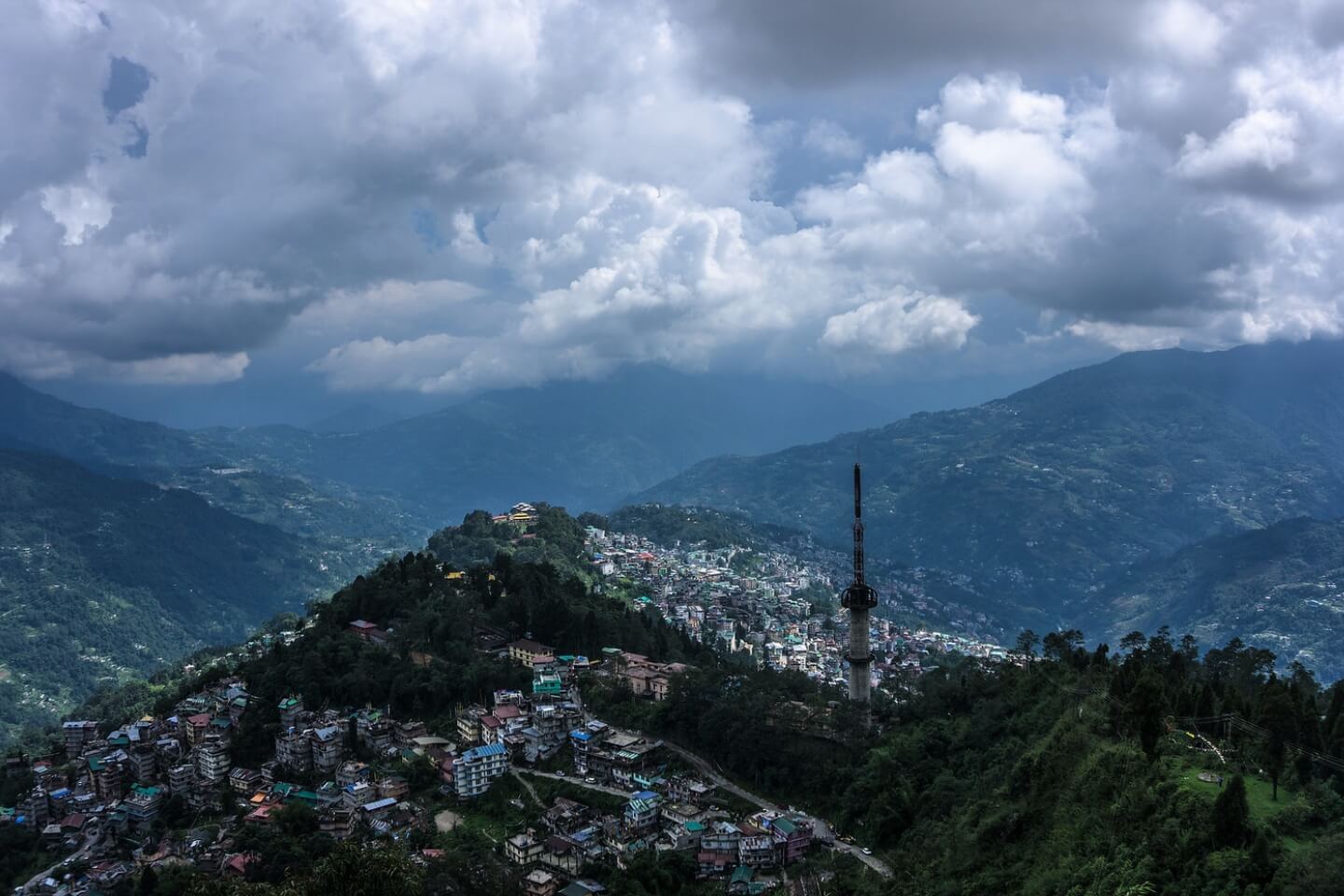
Located beside the Tashi Viewpoint, Ganesh Tok is a small temple (‘Tok’ literally means ‘Temple’ in local language) dedicated to Lord Ganesha. Ganesh Tok is situated at an elevation of 6,500 feet above sea level, at a distance of 7 kilometers from Gangtok and offers stunning views from the top, especially of the Khangchendzonga mountain.
Only one person can get inside the temple at a time due to its tiny size however, the lounge and the balcony are the main attraction of the place along with its stairs because of the colorful flags that are tied around them.
The temple was constructed during the year 1953 and becomes vibrant during the 10 day Ganesh Chaturthi festival when it is decked up in lights and flowers. The adjacent forest to the temple is called Smriti Van where the visitors can plant saplings.
- Timings: 6:00 AM – 7:00 PM
- Entry Fee: Free
7. Rumtek Monastery
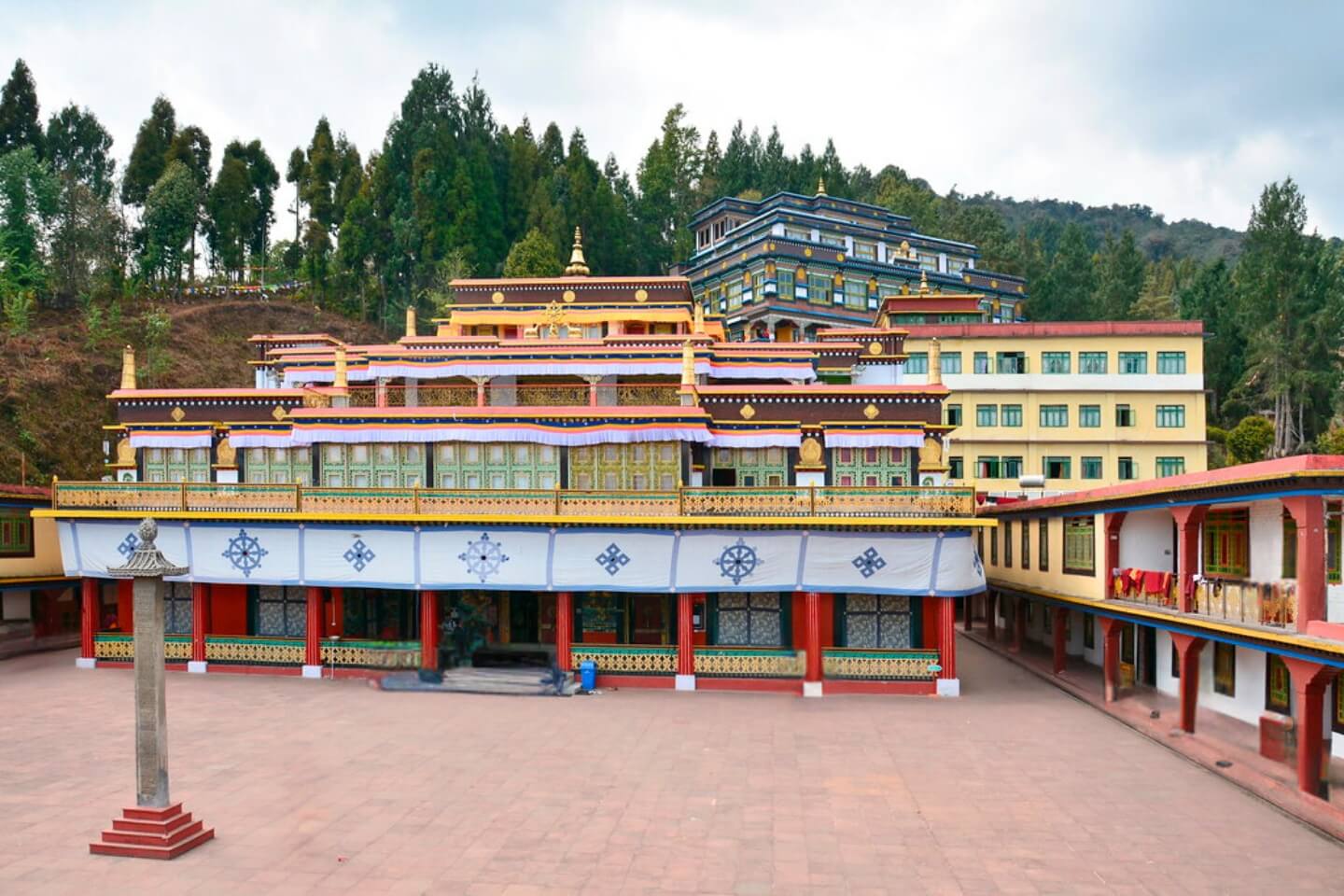
Located at a distance of 23 kilometers from Gangtok, the Rumtek Monastery is one of the largest and most popular monasteries on a hill- top. The monastery is the representation of divinity and spirituality and is very important for the Tibetan monks who reside here.
Also known as the Dhamma Chakra Centre, the Rumtek monastery was built in the 12th century by the Kagyu sect of Buddhists that originated in Tibet. The best way to experience the peace and serenity of the monastery is to participate in ‘Kora’, which is a devotional walk or circuit around the monastery in guidance of a Buddhist monk.
The monastery is a three storeyed building, the interiors of which includes rare Buddhist religious murals and thangkas. One of the unique artifacts at Rumtek monastery is a stupa of pure gold and a few sculptures that belonged to the 16th Karmapa along with a few unique scriptures in the world.
- Timings: 6:00 AM – 6:00 PM
- Entry Fee: ₹10 per person
8. Banjhakri Falls
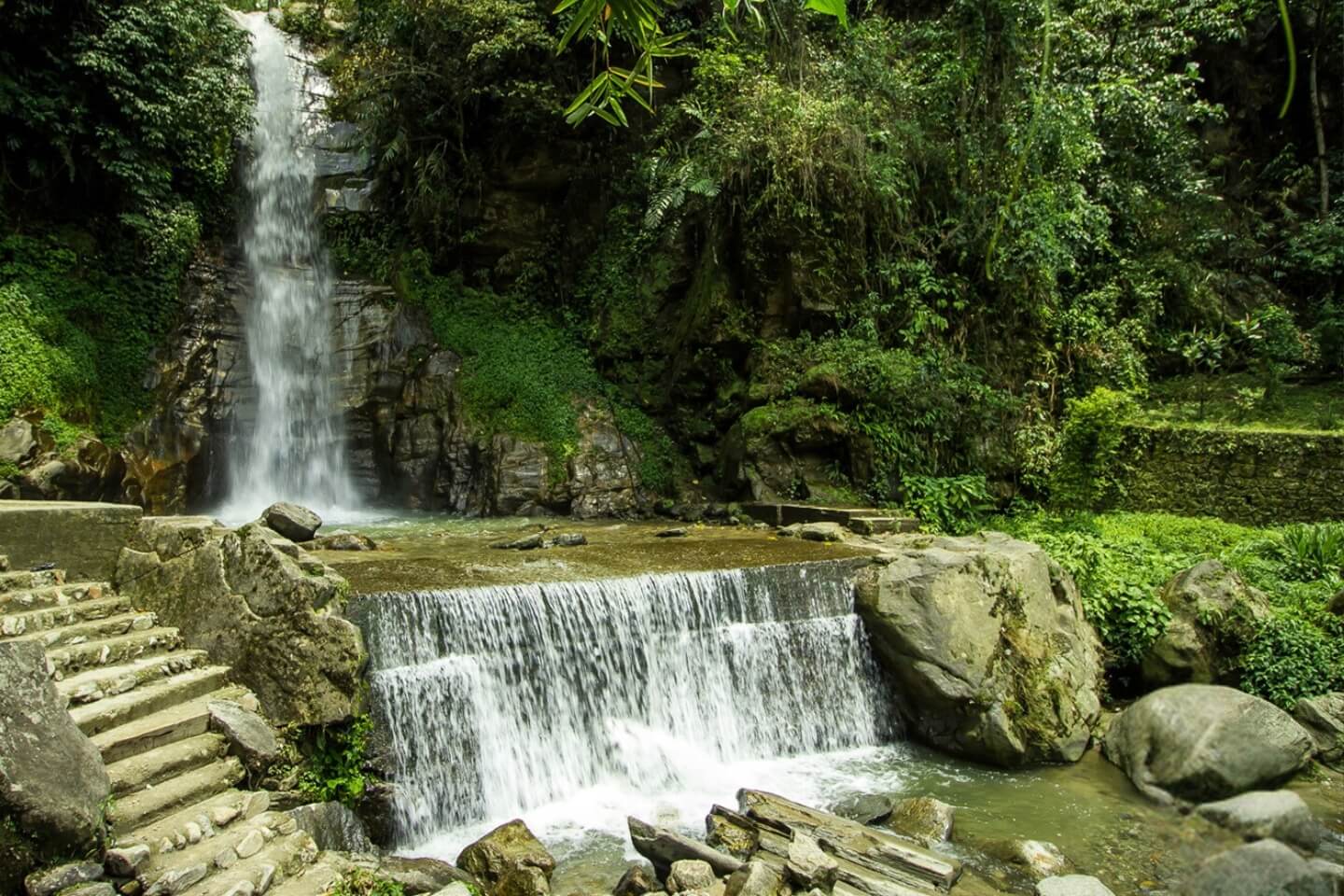
Located at a distance of 10 – 12 kilometers from Gangtok, on the way to Ranka Monastery, the Banjhakri waterfall cascades from 40 feet on to beautiful landscaped gardens that includes beautiful statues of Lyam Lymay, Mangpas, Lepcha, and Ban Jhakri ancestors. The name Banjhakri literally translates to ‘Traditional Healer’.
The local folktales and mythology beliefs exist in the Nepali community of Sikkim that a Shaman called Ban Jhakri who possesses unconventional powers resides in the forests and worships spirits. The figurines in the Energy Park depict rituals and healing ceremonies and induction rituals followed in the life of a shaman.
The waterfall visit is an amazing experience of unwinding in the wilderness, away from the hustle of the city center.
- Timings: 8:00 AM – 6:00 PM
- Entry Fee: ₹100 per person
9. Tsomgo Lake
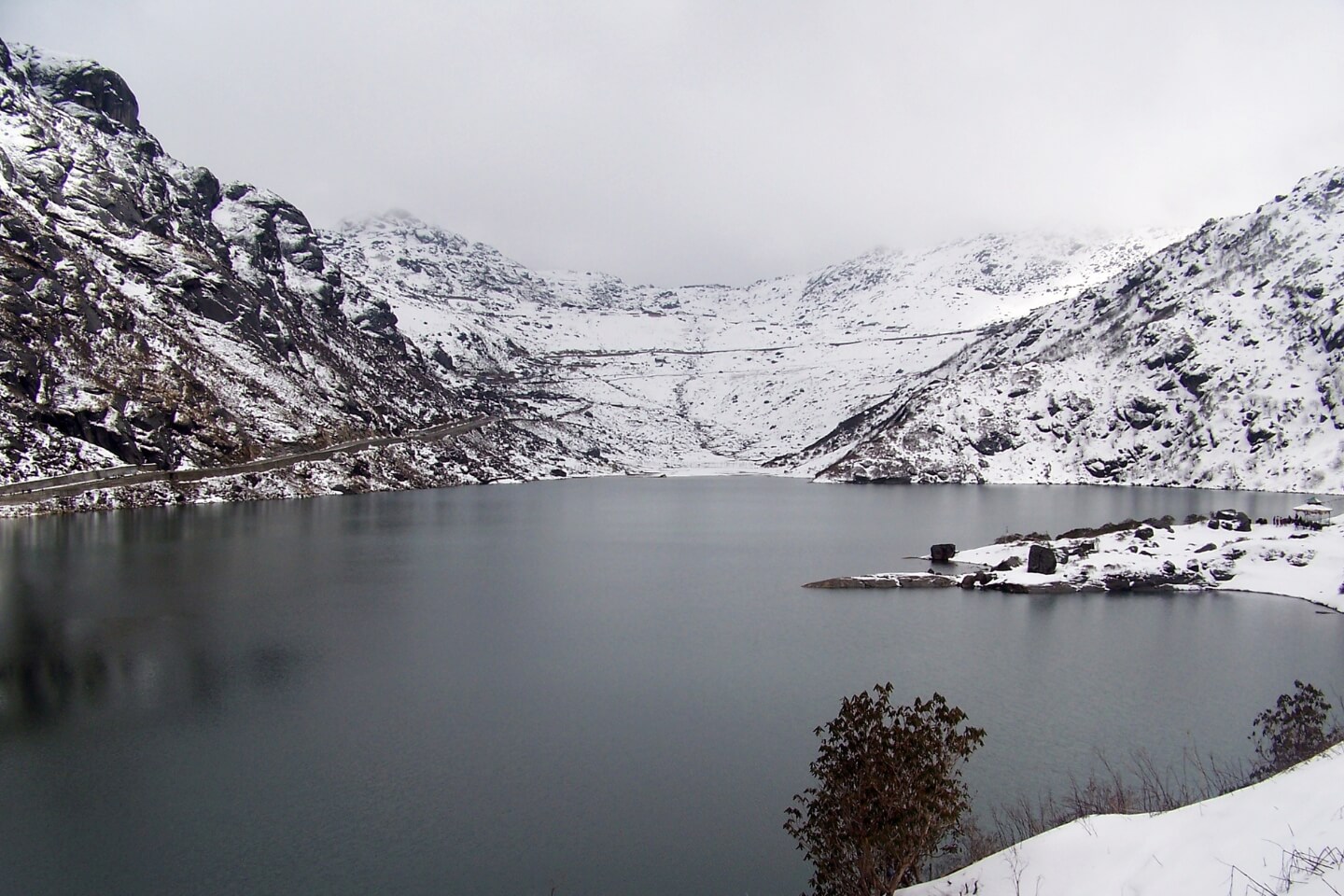
Popularly known as Changu Lake among the locals, Tsomgo Lake is a glacial lake located between mountains at an altitude of 12,400 feet above sea level and is among the few high- altitude lakes in India on the Gangtok – NathuLa highway. The lake derives its water from the melting snows of the mountains that surround it and is best known for its changing colors with changing seasons.
The color of the water of Tsomgo Lake is bright aquamarine during monsoon, and in winter, the lake freezes completely and forms a translucent sheet of ice. The bright colors of summer and fall flowers that bloom on the periphery of the lake lend vibrant colors to the water.
The lake holds deep religious and cultural significance for the Bhutia people as they consider it as a sacred place due to its association with myths and legends. It is believed that the monks used to decode the future based on their analysis of the color of the lake. The Jhakri community who are also known as the faith healers, believe in the magical powers of water and celebrate Guru Purnima near the lake as they consider the festival to be auspicious.
Due to its location in a restricted area, a special permit is required for both Indian and foreign nationals. There is no fee required to obtain the permit for Tsomgo Lake.
- Timings: 8:00 AM – 3:00 PM
- Entry Fee: Free (but permit required)
10. Namgyal Institute of Tibetology
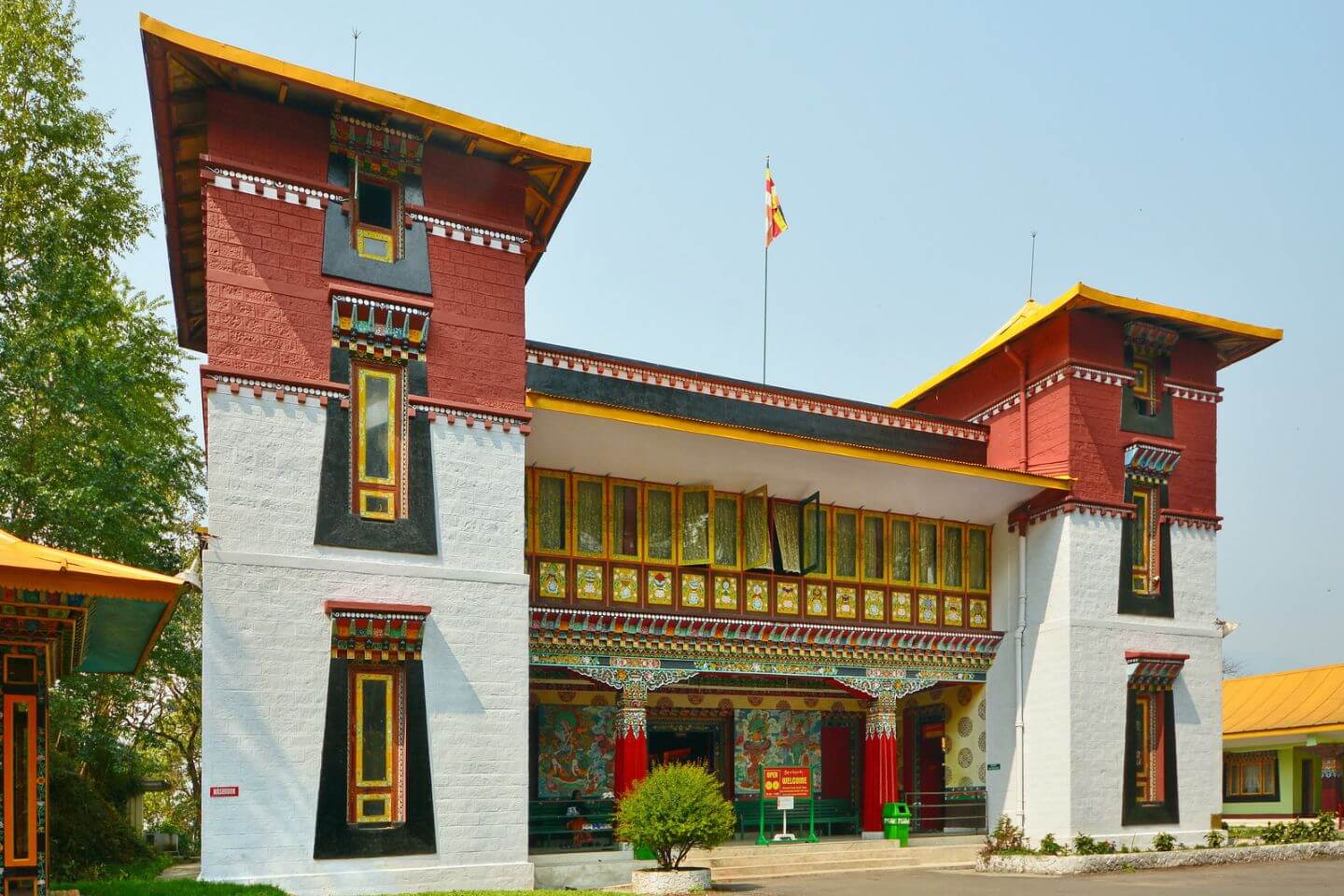
Home to centuries old Tibetan-Buddhist culture and history, the Namgyal Institute of Tibetology is the pioneer of preservation and promotion of Tibetan art and literature. It boasts an impressive collection in the museum and library which attract visitors from all around the world. The institute supports pursuers interested in study and research of Asian culture, Buddhist studies and preservation of Tibetan history, literature, philosophy, architecture and everything related to it.
The institute is named after the 11th Chogyal of Sikkim, Sir Tashi Namgyal and the foundation stone of the institute was laid by the great 14th Dalai Lama himself in 1957. The building structure is built in typical Tibetan architectural style with golden towers supporting its majestic facades. The Namgyal Institute was inaugurated by Pandit Jawahar Lal Nehru in 1958.
- Timings: 10:00 AM – 4:00 PM (Closed On Sundays, Second Saturdays)
- Entry Fee: ₹25 per person
11. Namchi
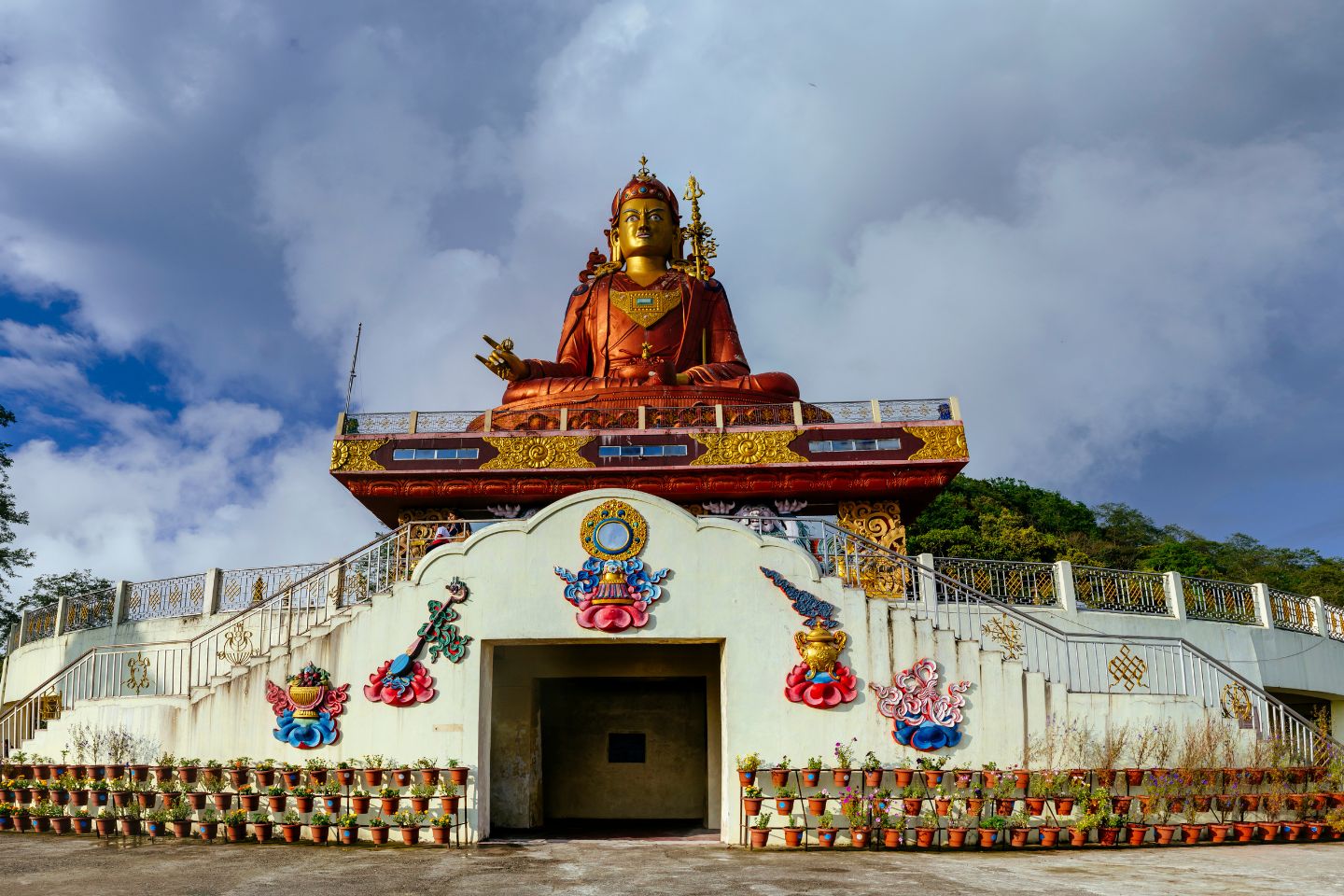
78 kilometers from Gangtok, situated at an elevation of 1675 meters above sea level, Namchi is the capital of South Sikkim district. It became popular among tourists and travelers because of the Samdruptse and Solophok statues along with the copper and bronze statue of Padmasambhava that stands tall and high at 45 meters. The name ‘Namchi’, which literally translates to ‘Top of the Sky’, offers stunning views of the Khangchendzonga range and Rangit valley.
The monasteries worth visiting in Namchi are the Sherdup Choeling Monastery, the Dichen Choeling monastery and the old Ngadak monastery, which is located just 2 kilometers from Namchi. Another interesting place to visit in Namchi is a rock garden situated on a hill just above the Ngadak monastery.
- Timings: 12:00 AM – 12:00 AM
- Entry Fee: Free
12. Magnan
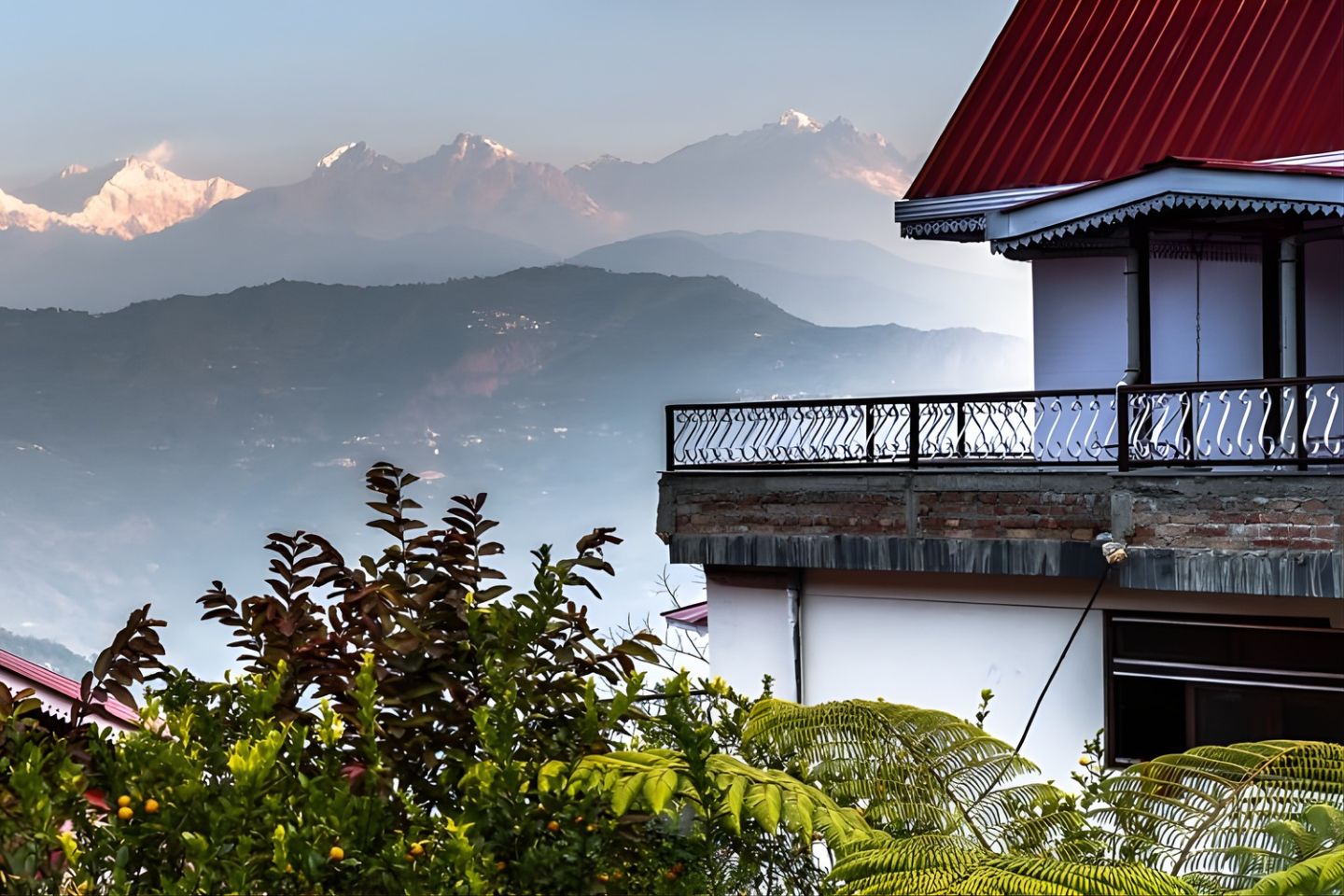
Known for its unaltered natural beauty, the small town of Magnan, which is also the capital of Northern Sikkim offers several activities for adventure enthusiasts starting from rock climbing, cycling, paragliding, camping, mountain biking. The town is surrounded by snow clad mountains, streams that offer fresh and sparkling water, wildflowers, mountain shrubs, and conifers.
Magnan is situated at an approximate distance of 59 kilometers from Gangtok and you can cover the distance in 2.5 hours. Labrang, Phodong and Houlong Monasteries are worth visiting along with Sirijunga Yuma Margheem, famous for its elaborate celebration of Manghey Sankranti (a winter festival). You may also visit the Rong Lungten Lee. It is a representation of the Lepcha traditional house, which has been converted into a museum.
If you are planning an elaborate stay in Sikkim, you might want to attend the three day music festival of Magnan, which is organized in December every year wherein, artists and bands from all North East Indian states gather and participate making it a very special occasion to be in Sikkim.
All in all, Magnan is a place that one needs to visit to understand the history and heritage of Sikkim better.
- Timings: 12:00 AM – 12:00 AM
- Entry Fee: Free
13. Tsuk La Khang Monastery
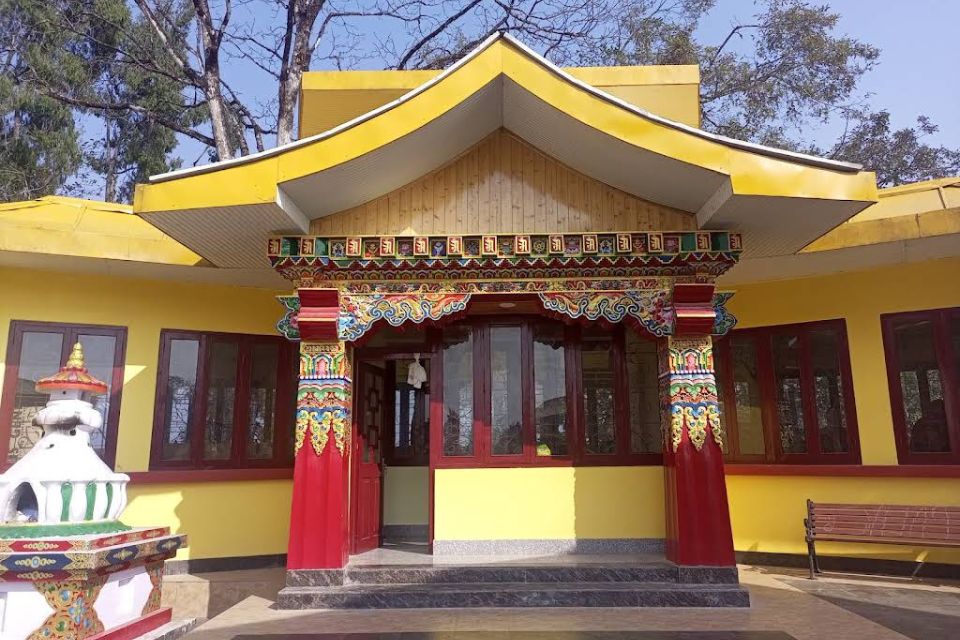
Located within the Tsuklakhang Royal Palace complex, the Tsuk La Khang Monastery is one of the most revered and popular monasteries in Gangtok since it is both a Buddhist Prayer Centre as well as the Royal Chapel of the Chogyals, the former Dharma Kings or monarchs of former Kingdom of Sikkim.
The monastery was commissioned by the 9th King, Thutob Namgyal and was built in 1898 AD. It was the hot spot for all royal celebrations and events starting from weddings to coronations to victory ceremonies. The locals call the monastery the Imperial Gompa due to its connection to royalty in the past.
The walls of the monastery are carved and painted with incredibly beautiful murals significant to Buddhist culture. There are images of deities carved on the altars too. The Buddhist scriptures, Buddhist literature and the intricate architectural details and techniques as well as the significant teachings of the Bodhisattvas are unique to the Royal monastery.
- Timings: 7:00 AM – 5:00 PM (Oct - Mar)
- Entry Fee: Free
14. Do Drul Chorten Stupa
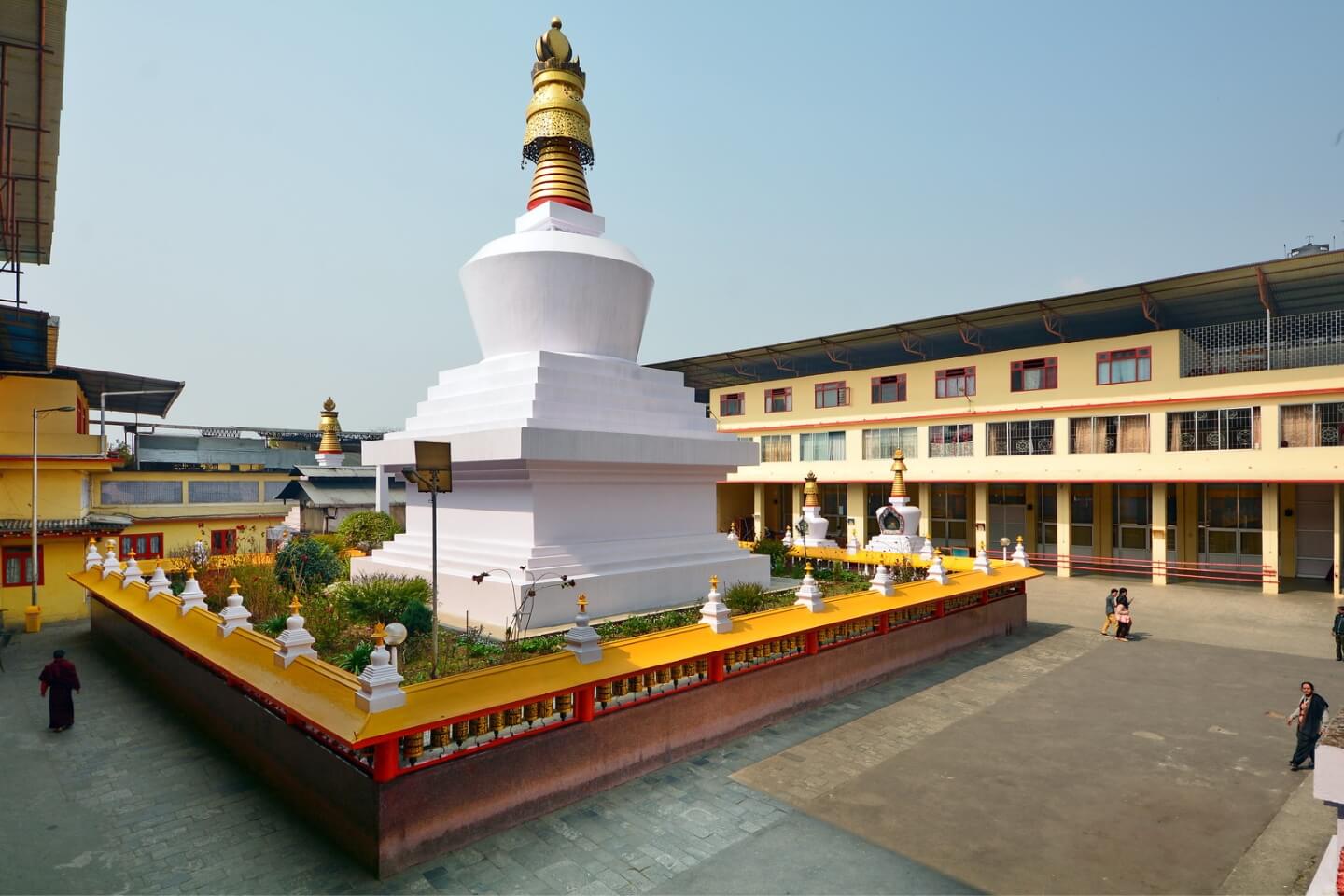
One of the most peaceful places in Gangtok is the Do Drul Chorten Stupa. The place offers immense serenity and if you are someone who loves to spend some time away from the hustle of marketplaces and other touristy places, Do Drul Chorten Stupa is a must visit for you. The stupa is famous for its 108 Mani Lhakor or the prayer wheels, as we commonly know them, are engraved with mantras. Devotees chant these mantras while also rotating the wheels one by one.
The stupa was built by the head of the Nyingma Order of Tibetan Buddhism, Trulshik Rinpoche in 1946 and is surrounded by Chorten Lakahang and Chorten Guru that house two statues of Padmasambhava, who is also called Guru Rinpoche.
There is a monastery for young lamas adjacent to the Chorten which is the dharma preaching center established by Dodhrubchen Rinpoche.
- Timings: 9:00 AM – 5:00 PM
- Entry Fee: Free
Seven Sisters Waterfalls
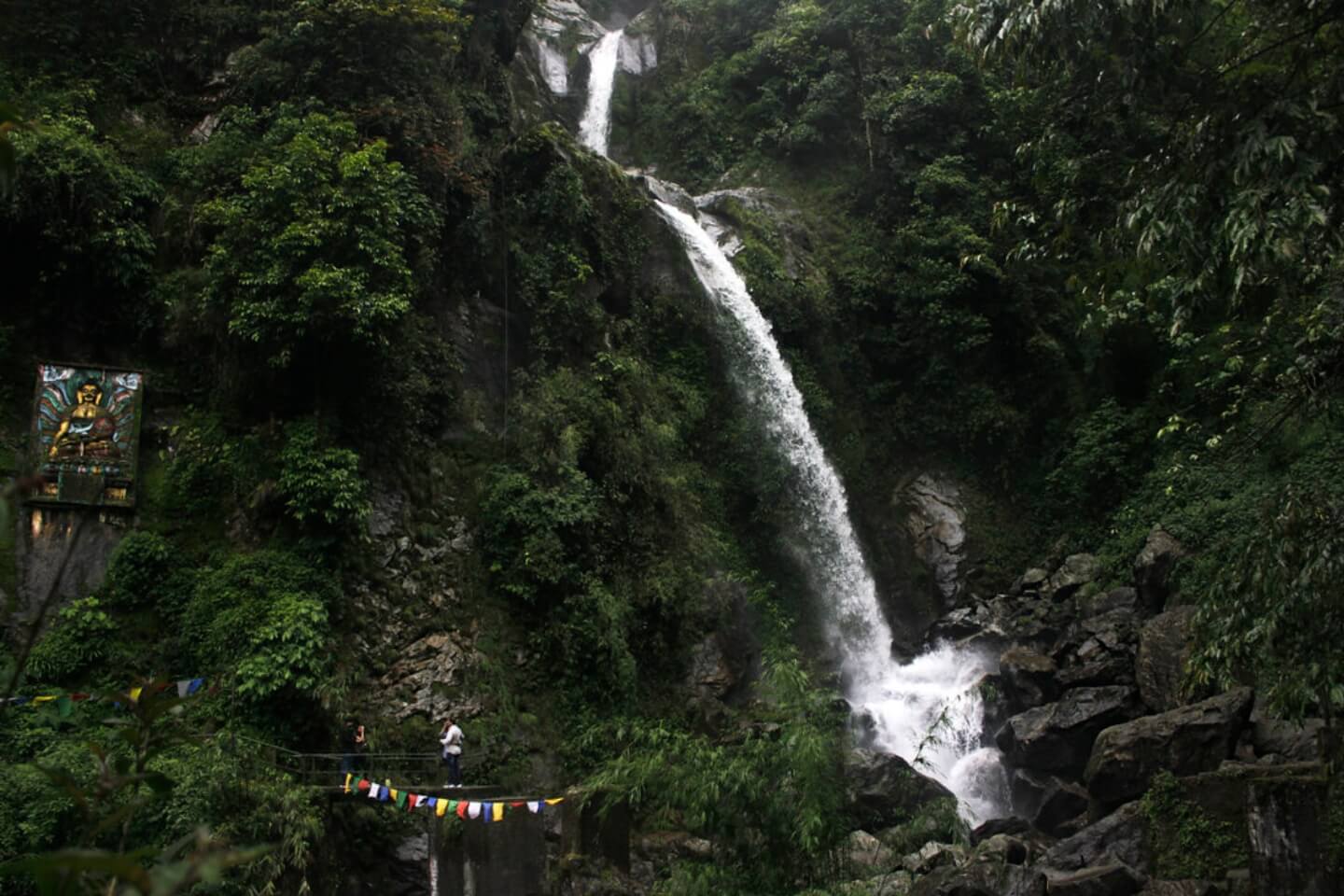
Located at a distance of 32 kilometers from Gangtok, the Seven Sisters Water- Fall is on the way to North Sikkim on the Gangtok – Lahchung highway. As the name suggests, the waterfall comprises seven separate waterfalls, cascading from the same height of a rugged cliff and are naturally arranged adjacent to each other. The view becomes even more beautiful during the monsoon when the falls are at their strongest.
The seven sisters waterfalls is the most photographed place in Sikkim due to its captivating views. There is a small foot- bridge at a lower level of the waterfall, over the stream. Photography enthusiasts can place themselves on the foot- bridge to get a better angle and shot of the fall. It is also a good option for families with kids to visit as the natural set up makes for an ideal picnic spot. There is a cafeteria and a waiting room built by the Tourism and Civil Aviation Department for travelers and visitors.
If you are here just after winter ends, when the snow starts to melt, make sure you pay a visit since the view of the melting snow from the waterfall is an awesome experience at another level.
- Timings: 8:00 AM – 5:00 PM
- Entry Fee: Free

